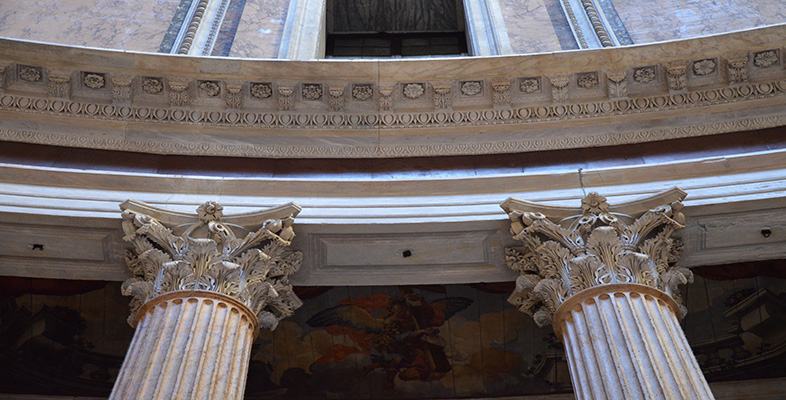2 Hadrianic monuments in Rome
Hadrianic Rome is notable for its innovative architecture, which makes it a fascinating study for anyone interested in Roman buildings. One significant monument of Hadrianic Rome was the Pantheon, and this will be the main focus of this section. The Temple of Zeus Asklepios in Pergamum, an important city in Asia Minor, was modelled on the Pantheon and this illustrates a second reason for studying the monuments of Hadrianic Rome: the extent to which they inspired Roman architecture elsewhere in the empire.
Elements of Hadrianic innovation can also be found elsewhere in Italy. The most elaborate example is Hadrian’s imperial villa at Tivoli, but we can also find more mundane examples, such as the shops and houses constructed of brick-faced concrete in the harbour town of Ostia. Both Trajan and Hadrian used brick-faced concrete.
Like many emperors before him, Hadrian embellished the Forum and Campus Martius areas of Rome, leaving his mark on the monumental landscape of the city. Few Hadrianic monuments have survived, especially those in the Campus Martius, and the identification of some structures is disputed. You will study three Hadrianic monuments in this section, all of them temples: the Pantheon, the Temple of Deified Hadrian and the Temple of Venus and Rome. The main reason we have chosen these structures is that they are the three best-preserved Hadrianic monuments in Rome. But we have also chosen them because Hadrian is not the only emperor to be associated with these monuments, and that allows us to explore how public buildings could be used by an emperor to help legitimise his position as successor to the previous princeps. The Pantheon had earlier phases and later restorations; the Temple of Deified Hadrian was built by his successor, Antoninus Pius; and the Temple of Venus and Rome was rebuilt in the early fourth century CE by one of Rome’s last emperors, Maxentius (Claridge, 2010, pp. 119, 226). Something to think about as you work through this section is how and why emperors restored or rebuilt the monuments of their predecessors, or dedicated new monuments to them, particularly temples. Immortalising a predecessor who had a good reputation was one way in which an emperor could legitimise his authority. This phenomenon had its roots in the Republican practice of dedicating temples to act as memorials of individuals and to promote elite families (gentes). This section explores how Hadrian used monumental building to weave himself into Rome’s imperial history, and how his successor did the same.
Activity 3
Visit the interactive map [Tip: hold Ctrl and click a link to open it in a new tab. (Hide tip)] and use the check-box to reveal the Hadrianic period and familiarise yourself with the monuments and buildings associated with Hadrian. Make yourself a timeline of Hadrianic monuments which contains the following information:
- the dates when the monument was built and restored – or rebuilt, if applicable (think about when this was in the context of Hadrian’s reign: for instance, was he in Rome when it was built? If so, how long had he been there and when did he make his next tour of the empire?)
- the names of individuals associated with the monument (such as the person who dedicated, built or rebuilt it, and the person or deities to whom it was dedicated)
- the reason for the construction of the monument
- the location of the monument
- the possible function(s) of the monument, where this is known.
Then, imagine that you have been asked to write an essay on Hadrian’s building programme at Rome. Use the information you have gathered to write a brief summary of his building activities and what they suggest about his motivations that you might use as part of an essay on this topic.
Spend no more than an hour on this activity.
Discussion
Hadrian restored or rebuilt at least two Augustan monuments: the Temple of Mars Ultor (in Augustus’ Forum) and the Pantheon (in the Campus Martius). He also designed and built the Temple of Venus and Rome and a mausoleum for himself. As we have noted, Antoninus Pius built the temple to the Deified Hadrian, following the practice of deifying and dedicating a temple to one’s predecessor. Hadrian did the same for Trajan when he became emperor, but the Temple of Deified Trajan built by Hadrian has not been conclusively identified.
All of these monuments are in either the Forum area or the Campus Martius, and most of them are temples. It was common practice for an emperor to be deified after his death and a temple built to honour him, usually by his immediate successor and usually in one of the Fora. Other members of the imperial family could also be deified (you will study an example later in this course). The practice of deification helped legitimise the rule of both the deceased emperor and his successor, indicating that imperial rule was divinely ordained. Building a temple ensured that the populace had a constant reminder of this, as well as demonstrating the piety and beneficence of the current emperor. You will study the topic of imperial deification more fully in Section 3 of this course.
